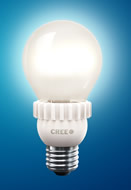The Hay Festival is an appropriate place for a lightbulb moment. I was at a talk where green guru Julia Hailes was talking about converting her old farmhouse and making it as environmentally efficient and green as possible.
I wrote down lots of things (not very efficiently, on my smartphone) but one slide caught my eye, a simple image in seductive rainbow colours and curves. It was a light bulb, in the new Philips Hue LED range, and it looked quite beautiful. Julia was fitting it in her home; her aim is to make it as carbon friendly a dwelling as possible and her illumination is to be 100% LED.
The Hue web-enabled system, which connects to the Wi-Fi router in the home, can be controlled from anywhere through a smartphone. You can turn the lights on, up or down, and change them to almost any colour you wish.
The system enables you to create and save light settings—bright lights when the kids do homework, for example, and a softer setting for the grownups once the children are asleep. You can also set lights to go on and off at specific times, or to slowly brighten in the morning. With additional programming the lights can be made to turn on when you approach the house, and to turn off automatically when you’re leaving. And, because it is an LED, the Hue consumes very little electricity. Julia said the Hue was expensive but not “prohibitively so”. That’s $199 in the US for the whole kit, including three lightbulbs and the “bridge”, an electronic device that connects the lights to your Wi-Fi. It will soon be on sale in Apple stores.
It is indeed expensive, and, for the time being, it’s probably mainly for the rather well-off early adopter. Reading several complimentary reviews I found a much less expensive LED light, made by US company Cree.
Cree claims to be doing nothing less than making Thomas Edison’s incandescent light bulb obsolete. (The EU is phasing it out in Europe, while it is still on sale in the USA.) Cree says it was inspired by Edison’s own injunction: ‘There’s a better way to do it. Find it.’
The Cree lightbulb comes close to matching the sort of light given off by the standard incandescent bulb, while consuming 10% of the energy. And it uses roughly (or a little bit less than) half the energy consumed by the compact fluorescent lamp (CFL), the standard energy-saving lamp up on the market today.
When the EU ban on sales of the incandescent light came in in 2009, one argument put forward by supporters of that technology, developed by Edison a hundred years ago, was that the quality of the LED’s light simply wasn’t good enough.
Early consumer reports on the Cree suggest the company may have overcome that objection with its 60W-equivalent, the Cree 9.5-Watt A19 Warm White (2700K) Dimmable LED bulb. It costs around $13 in the USA, and is not yet available in the UK.
A writer on the website http://thesweethome.com noted: “I’ve been writing about the electronic design industry for 15 years, and I’ve never seen an LED light bulb with a better combination of features than the Cree. It’s dimmable, has high quality color, is long lasting, has a 10 year warranty and makes as much light as a 60-watt incandescent bulb. It’s my new favorite LED light bulb.” (http://thesweethome.com/reviews/the-best-led-lightbulb-is-the-cree-warm-white/)
The best comparison website I could find explains the difference. The regular LED bulb has a projected 50,000 hours lifespan. Compare that with the 1200 hours of the incandescent and the 8000 of the CFL.
The higher cost of the LEDs, particularly if you buy them in big numbers – say for an entire house – would be recouped in a very short time, possibly in a year, certainly within two or three years. And that’s when they’re being compared with CFLs.
A cynical person might ask – where’s the built-in obsolescence? These new LEDs do seem to have an enviable longevity, and, let’s face it, are likely to outlive many of the older customers who buy them.
They should think of them as part of the house. After all, you buy a painting or ornament to pass on, not to see it fade away before you are gone. You don’t begrudge future generations the opportunity to enjoy it or make use of it.
What if housebuilders were to fit them as standard (perhaps offering customers a choice within a certain price range)? They would make an immediate, and significant, contribution to reducing the UKs CO2 output. They could do, but most likely won’t. This is an energy revolution that will probably be led by the consumer.
As for the Philips Hue, I’m still bedazzled, but shall probably wait for the price to come down

